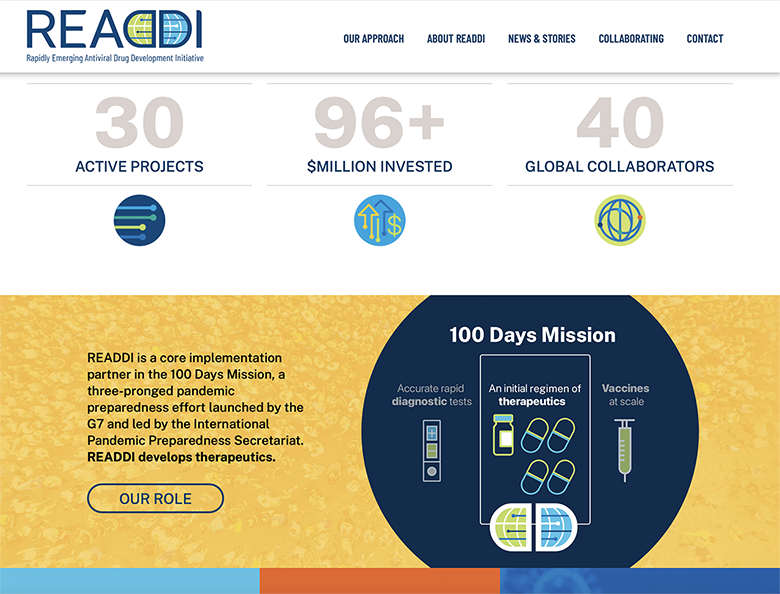How are pharmacy schools taking lessons learned from the COVID-19 pandemic and applying them to research to identify and combat emerging pandemics?
By Joseph A. Cantlupe
As the COVID-19 pandemic wanes, resurges, lays low and sometimes intensifies, researchers at pharmacy and medical schools are playing a big role in examining ways to thwart the next waves of the coronavirus as well as other viruses that could evolve into pandemics. Academic institutions around the country are working diligently to assess potential threats already under exploration before 2020, with a focus on viruses impacting humans and animals. Researchers are carrying out these studies within and beyond the halls of academia, teaming up with industry and other partners to develop innovative programs to contain viruses before they spread uncontrollably.
The University of North Carolina Eshelman School of Pharmacy is concentrating on developing pills that can combat pandemic-level viruses like COVID-19 at its Anti-Viral Drug Discovery Center (AViDD). The university received a $65 million grant from the National Institute of Allergy and Infectious Diseases to run the program under its Rapidly Emerging Antiviral Drug Development Initiative (READDI).
Dr. Tim Willson, chief scientist of the Structural Genomics Consortium at the UNC Eshelman School of Pharmacy, and his lab team members are developing and opening sharing with the scientific community small molecule chemical probes of the dark proteome. He said the multidisciplinary effort fits nicely with the curriculum for student pharmacists and for other scientists working to engage with new antiviral therapies. The work is particularly illuminating for students, giving them an opportunity to experience all facets of the drug discovery process.

Willson is particularly pleased that their work, carried out by experts in medicinal chemistry, cell biology and chemical biology, is considered “open science,” meaning that their published findings are shared quickly throughout the world. “The drug molecules, data and everything we do in my lab goes on in the public domain,” Willson noted. “That’s one of the biggest drivers for me. What we’re doing is for society’s benefit. More drugs can be produced that way.”
He is quoted on UNC’s website: “Open Science guides the way we practice science and maintain the quality of our work. Openness is what sets SGC apart from other academic labs. Our goal is to distribute reagents and data without restrictions to the community and to enable other scientists to make immediate use of our discoveries. We deposit copies of all manuscripts on preprint servers as soon as they are ready for submission so that publication of our research is not delayed by the review process.”
One example of that effort, Willson said, involved the discovery of certain enzymes that appeared to be shutting down replication of the virus that causes COVID-19. He said the lab quickly published the information, making it widely available. READDI has also developed animal models to test inhibitors of alpha viruses, which include severe pathogens that attack the brain causing encephalitis and are often fatal. “We are making great progress with drugs that can block these viruses, which are found in many parts of the U.S., including North Carolina,” he said.


 “Investment in antiviral drug discovery through open science is the best way to ensure that the world is prepared for the next pandemic.”
“Investment in antiviral drug discovery through open science is the best way to ensure that the world is prepared for the next pandemic.”
 “We have to do a much better job of modeling these infectious diseases, incorporating economic behaviors, which many epidemiologic models miss.”
“We have to do a much better job of modeling these infectious diseases, incorporating economic behaviors, which many epidemiologic models miss.” The Center’s international collaborators include the University of Toronto; Diamond Light Source LTD; Sichting VU; Duke University; McGill University; Rutgers University; the University of Alberta; the University of Wisconsin-Madison; University College London; and Vanderbilt University and the Vanderbilt University Medical Center. Willson said the collaborators often have discussions to evaluate the process of drug discovery. “Investment in antiviral drug discovery through open science is the best way to ensure that the world is prepared for the next pandemic,” he emphasized.
The Center’s international collaborators include the University of Toronto; Diamond Light Source LTD; Sichting VU; Duke University; McGill University; Rutgers University; the University of Alberta; the University of Wisconsin-Madison; University College London; and Vanderbilt University and the Vanderbilt University Medical Center. Willson said the collaborators often have discussions to evaluate the process of drug discovery. “Investment in antiviral drug discovery through open science is the best way to ensure that the world is prepared for the next pandemic,” he emphasized. One of Basu’s colleagues, Dr. Deborah Fuller, professor of microbiology at the University of Washington School of Medicine, had been working on developing vaccines and antivirals prior to the pandemic. “There’s always going to be another pandemic as long as humans and animals are living in the world together,” Fuller said, “as has happened throughout time and history. What COVID-19 did was bring it out to the forefront for society. We must be more prepared than ever—COVID-19 has helped us develop some of those tools and now we apply those and hopefully we will be in a better situation to stem the next pandemic.”
One of Basu’s colleagues, Dr. Deborah Fuller, professor of microbiology at the University of Washington School of Medicine, had been working on developing vaccines and antivirals prior to the pandemic. “There’s always going to be another pandemic as long as humans and animals are living in the world together,” Fuller said, “as has happened throughout time and history. What COVID-19 did was bring it out to the forefront for society. We must be more prepared than ever—COVID-19 has helped us develop some of those tools and now we apply those and hopefully we will be in a better situation to stem the next pandemic.”